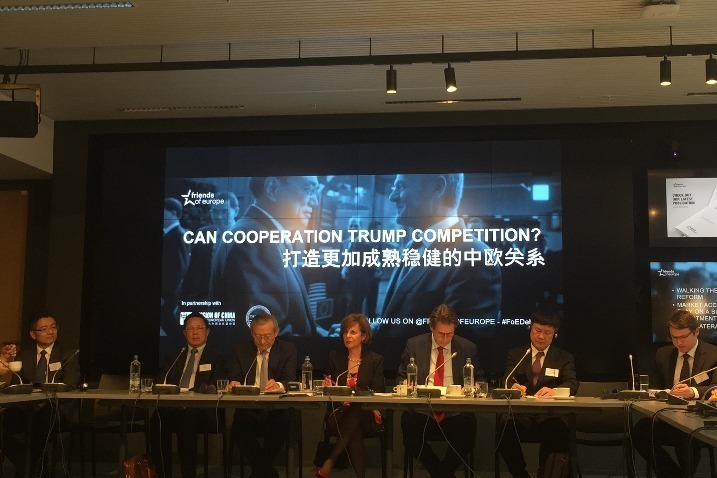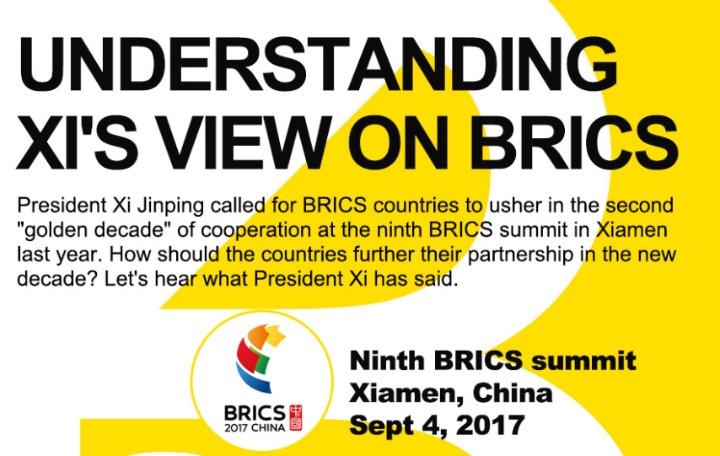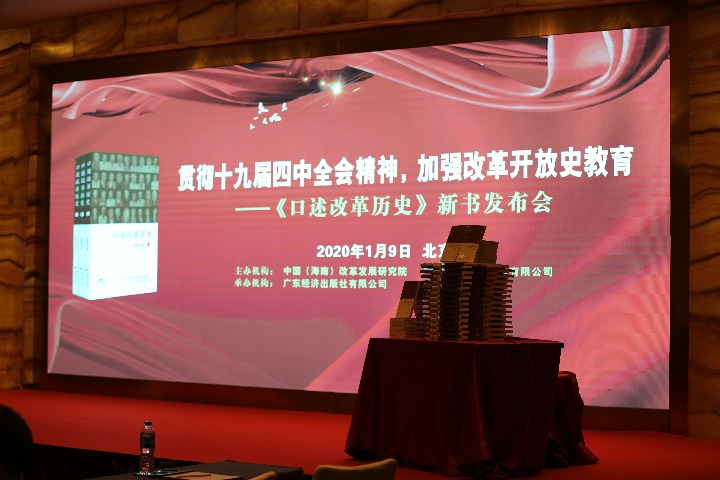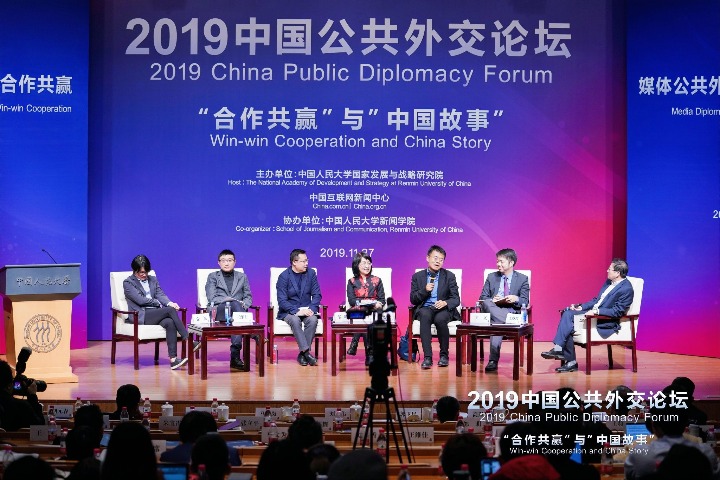Reforms can add gloss to leather industry
By Hubert Rudolph Kollmar |
chinawatch.cn |
Updated: 2019-04-25 09:23
Growing up in Western Europe during the 1960s and '70s, China was a world away for me. Particularly during the height of the Cold War my exposure to China’s history, culture and development was very limited.
Nor did I know about the fact that China had been the world's largest and most advanced economy before the 19th century. In the 18th century,Adam Smith claimed China had long been one of the richest, that is, one of the most fertile, best cultivated, most industrious, most prosperous and most urbanized countries in the world. The economy stagnated beginning in the 16th century and even declined in absolute terms in the 19th and much of the 20th century, with a brief recovery in the 1930s.
After graduating from Mannheim University with a master's degree in business administration my first job was with the German government in the privatization of the former East German state-owned economy.But I still had no idea how much that would prepare me for my later career and how much China would be a major part in this development.
When I changed jobs in the 1990s, my boss told me that my future would be in China. And I still had no clue how much truth was in those words.Originally sent to China on business trips and an early two-year assignment in a global chemical company investing in China my journey started and after 24 years I am thankful for the opportunity to be part of the amazing development in China as well as witness Chinese reforms and opening-up. I have had the chance to work with and cooperate with a Chinese family-owned private enterprise during the last eight years.
While I was studying and then taking the first steps in my career, on the other side of the world, Deng Xiaoping initiated in two stages the reform and opening-up of China, known as “Socialism with Chinese characteristics”.
The first stage in the late 1970s and early '80s involved the decollectivization of agriculture, the opening up of the country to foreign investment, and permission for entrepreneurs to start businesses. In the late 1980s and early '90s, the second stage focused on privatization and contracting out state-owned industries, and lifting price control and protectionist policies.
The world was watching with awe the development, particularly the average annual economic growth of 9.5 percent from 1978 until 2013. Remarkable is also the fact that more than 70 percent of the GDP is generated by the private sector of the Chinese economy!
The leather industry in China was never one of the biggest but certainly one of the oldest and can be segmented into two major parts; the leather producing industry linked to the meat industry for the supply of hides and skins and other focusing on the production of consumer goods ranging from shoes, furniture, garments and all kinds of goods for daily use.
Besides the hides and skins, the most important ingredient for leather making is chemicals, with the leather chemical industry also being the innovation driver for the industry. Globally, the heart of this leather chemical industry is located in Europe, particularly in Germany and Italy.
During my first trips to China my assignment was a market survey on the State-owned leather producing and domestic leather chemical industries.
The development of these segments during the 1990s has been dramatic and reflect the impact of the Chinese reforms and opening-up. Where as in the early 1990s,30-40 percent of China's leather production was by State owned enterprises, there were only eight State-owned leather chemical companies operating. By the end of the 1990s,most of these companies disappeared or did not play a major role anymore.
During the 1990sand around the time the State-owned sector was declining, the second stage of Deng’s reforms opened the way for the development of private leather chemical companies, which started as spin-offs or management buy outs from financially failing State-owned companies. With a leading role of Sichuan University as an R&D center for the industry it is no surprise that Sichuan companies took the lead. With the support of the local government and the Party these enterprises developed fast and started to dominate the domestic-oriented part of the industry, which was approximately 30 percent of the total leather industry.
But what would keep these young companies from committing the same mistakes as the earlier State-owned generation? For this the understanding of the fundamental problem of the older generation is essential. Price controls and the lack of structured and systematic financial and management accounting was leading to a lack of transparency and many times ended in wrong and bad decisions by the managers of these companies. The reforms lifted price controls and let the companies make price decisions. But how can you do this without a proper understanding of fixed and variable costs? Most of the time tax accounting was the only accounting of the young private enterprises. Over-capacity, ineffectiveness and most of all inefficiencies dominated the day to day business.
On the technological side the products of these companies were based on chemical copies of international successful products, but with the comprehensive knowledge missing to link and combine application know-how, process knowledge, production technology and systematic quality management.
These rapidly growing leather chemical companies needed to consolidate and move toward the next step, which can be characterized as the way to international management based on Chinese heritage and culture.
My client and cooperation partner in Sichuan province is one of six to eight domestic private enterprises in the leather chemical sector faced with this situation. The board of directors of this company realized in order to move forward into a sustainable future a systematic and structured management is necessary instead of ineffective and inefficient copying of international companies.
The task on hand was to establish international management processes and structures without losing Chinese heritage and culture.
Much to the surprise of my partners in China, we did not focus on entering international markets, but rather focused on a consolidation and focus on the existing business. The most important and crucial reform at the company level was establishing management accounting structures and the role of an internationally-proven ERP system. ERP, or Enterprise Resource Planning, opened the eyes of the directors and consequently led to better management decisions.
Pricing was changed to a contribution margin system and fixed and variable cost understanding consistently improve defficiency in day to day operations. The adjustment of the company organization driven by value-based management led to well documented, structured and systematic processes, which now enables the company to walk the talk.
The challenge in this process was establishing conceptual thinking and strategic orientation throughout the streamlined management layers of the company. There are hundreds of books in the market on strategic management, many of them available in China in translated versions, but why were we struggling with implementation? We find visions and missions, codes of conduct and sales and marketing. But why were we not growing accordingly? The lack of conceptual thinking and strategic orientation was slowing down this process. Most young graduates from university dream of highly paid jobs in sales, but have little or no understanding of cost accounting and most of all no patience for solid career development to acquire the necessary experience.
The key to that problem is corporate communications, which is to ensure the well defined vision and mission, strategies, concepts, measures and actions are understood by all stakeholders of a value-based management.
When we see the main stakeholders and their expectations of an enterprise, we immediately see the crucial role of the government and the Party in this process.
From my perspective as a partner of a small family-owned private enterprise in China I can see the following challenges and opportunities for companies and the government:
To satisfy the expectations of Investors and earning a premium on our costs of capital there is an urgent need to for long-term investment planning by companies based on better understanding and communication with the tax authorities as well as the government understanding of individual needs. We need an urgent reform of government project management within universities, government and enterprises. Result-oriented targets and objectives need to be established, defined, measured, monitored and rewarded.
As mentioned before the biggest challenge is the change of the sales system. How can we help our customers to be more successful in the long term and be sustainable? Here the need is for more conceptual understanding of the government and the Party for the future needs and requirements of the industry and the enterprises in it. This understanding will lead to simplifying laws and regulations, which are fundamental for a management by structure and system rather than management by exception.
Particularly for companies located outside of the bigger cities, it is almost impossible to find the best teams. The government and the Party can support by better developing infrastructure of these areas in regards to housing, education, public transportation and recreation. Local taxes spent wisely on improvement of the attractiveness of a location for academics as well as foreigners will lead to fast growth in this areas.
This article is selected from a book, The Sleeping Giant Awakes, jointly published by China Daily’s communication-led think tank China Watch and Guangdong People's Publishing House.
The author contributed this article to China Watch exclusively. The views expressed do not necessarily reflect those of China Watch.
All rights reserved. Copying or sharing of any content for other than personal use is prohibited without prior written permission.
Growing up in Western Europe during the 1960s and '70s, China was a world away for me. Particularly during the height of the Cold War my exposure to China’s history, culture and development was very limited.
Nor did I know about the fact that China had been the world's largest and most advanced economy before the 19th century. In the 18th century,Adam Smith claimed China had long been one of the richest, that is, one of the most fertile, best cultivated, most industrious, most prosperous and most urbanized countries in the world. The economy stagnated beginning in the 16th century and even declined in absolute terms in the 19th and much of the 20th century, with a brief recovery in the 1930s.
After graduating from Mannheim University with a master's degree in business administration my first job was with the German government in the privatization of the former East German state-owned economy.But I still had no idea how much that would prepare me for my later career and how much China would be a major part in this development.
When I changed jobs in the 1990s, my boss told me that my future would be in China. And I still had no clue how much truth was in those words.Originally sent to China on business trips and an early two-year assignment in a global chemical company investing in China my journey started and after 24 years I am thankful for the opportunity to be part of the amazing development in China as well as witness Chinese reforms and opening-up. I have had the chance to work with and cooperate with a Chinese family-owned private enterprise during the last eight years.
While I was studying and then taking the first steps in my career, on the other side of the world, Deng Xiaoping initiated in two stages the reform and opening-up of China, known as “Socialism with Chinese characteristics”.
The first stage in the late 1970s and early '80s involved the decollectivization of agriculture, the opening up of the country to foreign investment, and permission for entrepreneurs to start businesses. In the late 1980s and early '90s, the second stage focused on privatization and contracting out state-owned industries, and lifting price control and protectionist policies.
The world was watching with awe the development, particularly the average annual economic growth of 9.5 percent from 1978 until 2013. Remarkable is also the fact that more than 70 percent of the GDP is generated by the private sector of the Chinese economy!
The leather industry in China was never one of the biggest but certainly one of the oldest and can be segmented into two major parts; the leather producing industry linked to the meat industry for the supply of hides and skins and other focusing on the production of consumer goods ranging from shoes, furniture, garments and all kinds of goods for daily use.
Besides the hides and skins, the most important ingredient for leather making is chemicals, with the leather chemical industry also being the innovation driver for the industry. Globally, the heart of this leather chemical industry is located in Europe, particularly in Germany and Italy.
During my first trips to China my assignment was a market survey on the State-owned leather producing and domestic leather chemical industries.
The development of these segments during the 1990s has been dramatic and reflect the impact of the Chinese reforms and opening-up. Where as in the early 1990s,30-40 percent of China's leather production was by State owned enterprises, there were only eight State-owned leather chemical companies operating. By the end of the 1990s,most of these companies disappeared or did not play a major role anymore.
During the 1990sand around the time the State-owned sector was declining, the second stage of Deng’s reforms opened the way for the development of private leather chemical companies, which started as spin-offs or management buy outs from financially failing State-owned companies. With a leading role of Sichuan University as an R&D center for the industry it is no surprise that Sichuan companies took the lead. With the support of the local government and the Party these enterprises developed fast and started to dominate the domestic-oriented part of the industry, which was approximately 30 percent of the total leather industry.
But what would keep these young companies from committing the same mistakes as the earlier State-owned generation? For this the understanding of the fundamental problem of the older generation is essential. Price controls and the lack of structured and systematic financial and management accounting was leading to a lack of transparency and many times ended in wrong and bad decisions by the managers of these companies. The reforms lifted price controls and let the companies make price decisions. But how can you do this without a proper understanding of fixed and variable costs? Most of the time tax accounting was the only accounting of the young private enterprises. Over-capacity, ineffectiveness and most of all inefficiencies dominated the day to day business.
On the technological side the products of these companies were based on chemical copies of international successful products, but with the comprehensive knowledge missing to link and combine application know-how, process knowledge, production technology and systematic quality management.
These rapidly growing leather chemical companies needed to consolidate and move toward the next step, which can be characterized as the way to international management based on Chinese heritage and culture.
My client and cooperation partner in Sichuan province is one of six to eight domestic private enterprises in the leather chemical sector faced with this situation. The board of directors of this company realized in order to move forward into a sustainable future a systematic and structured management is necessary instead of ineffective and inefficient copying of international companies.
The task on hand was to establish international management processes and structures without losing Chinese heritage and culture.
Much to the surprise of my partners in China, we did not focus on entering international markets, but rather focused on a consolidation and focus on the existing business. The most important and crucial reform at the company level was establishing management accounting structures and the role of an internationally-proven ERP system. ERP, or Enterprise Resource Planning, opened the eyes of the directors and consequently led to better management decisions.
Pricing was changed to a contribution margin system and fixed and variable cost understanding consistently improve defficiency in day to day operations. The adjustment of the company organization driven by value-based management led to well documented, structured and systematic processes, which now enables the company to walk the talk.
The challenge in this process was establishing conceptual thinking and strategic orientation throughout the streamlined management layers of the company. There are hundreds of books in the market on strategic management, many of them available in China in translated versions, but why were we struggling with implementation? We find visions and missions, codes of conduct and sales and marketing. But why were we not growing accordingly? The lack of conceptual thinking and strategic orientation was slowing down this process. Most young graduates from university dream of highly paid jobs in sales, but have little or no understanding of cost accounting and most of all no patience for solid career development to acquire the necessary experience.
The key to that problem is corporate communications, which is to ensure the well defined vision and mission, strategies, concepts, measures and actions are understood by all stakeholders of a value-based management.
When we see the main stakeholders and their expectations of an enterprise, we immediately see the crucial role of the government and the Party in this process.
From my perspective as a partner of a small family-owned private enterprise in China I can see the following challenges and opportunities for companies and the government:
To satisfy the expectations of Investors and earning a premium on our costs of capital there is an urgent need to for long-term investment planning by companies based on better understanding and communication with the tax authorities as well as the government understanding of individual needs. We need an urgent reform of government project management within universities, government and enterprises. Result-oriented targets and objectives need to be established, defined, measured, monitored and rewarded.
As mentioned before the biggest challenge is the change of the sales system. How can we help our customers to be more successful in the long term and be sustainable? Here the need is for more conceptual understanding of the government and the Party for the future needs and requirements of the industry and the enterprises in it. This understanding will lead to simplifying laws and regulations, which are fundamental for a management by structure and system rather than management by exception.
Particularly for companies located outside of the bigger cities, it is almost impossible to find the best teams. The government and the Party can support by better developing infrastructure of these areas in regards to housing, education, public transportation and recreation. Local taxes spent wisely on improvement of the attractiveness of a location for academics as well as foreigners will lead to fast growth in this areas.
This article is selected from a book, The Sleeping Giant Awakes, jointly published by China Daily’s communication-led think tank China Watch and Guangdong People's Publishing House.
The author contributed this article to China Watch exclusively. The views expressed do not necessarily reflect those of China Watch.
All rights reserved. Copying or sharing of any content for other than personal use is prohibited without prior written permission.









